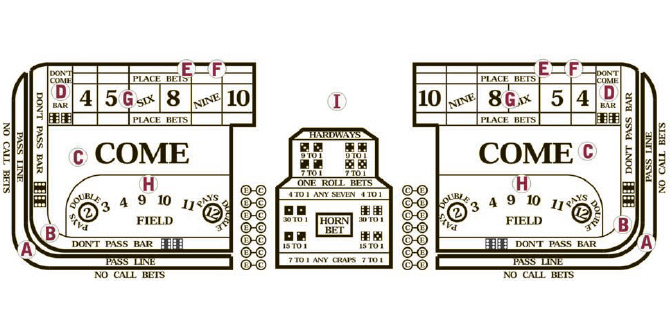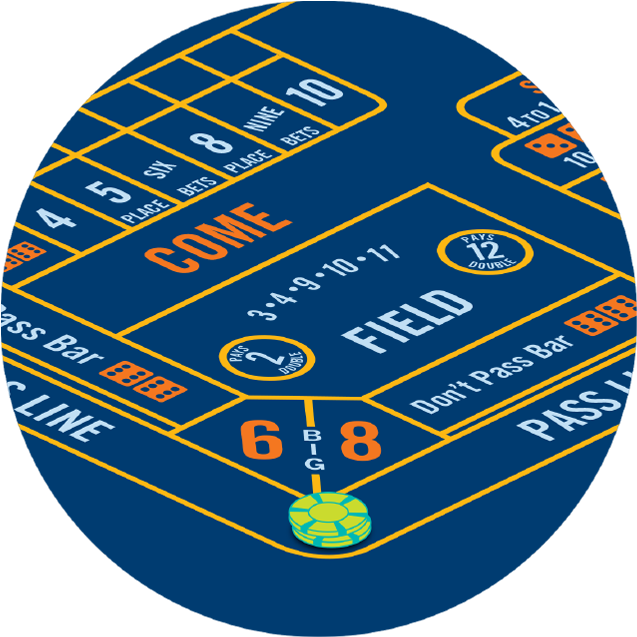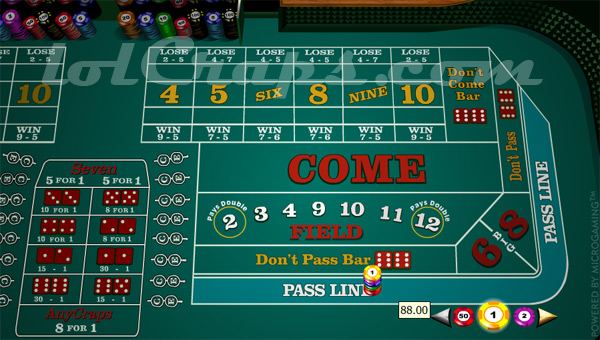In the case of craps, the house edge for the pass and come bets is the same – 1.41%. The house edge for the don’t pass and don’t come bets is 1.36%. The great thing is the house edge for the free odds bet. It’s called “free” odds because it carries no house edge. The pass line bet gives a house an edge of 1.414%. If you wage $100 on the Pass Line, then your average loss for that bet is 1 dollar and 41 cents. Wrong bettors bet on the Don’t Pass and they hope that the dice will loose. The Don't Pass bettors are automatic winners on the come-out roll if a 2 or 3 are rolled. The 12 is, however, a standoff between wrong bettors and the house.
THE DARK SIDE
What is the dark side of craps? It’s not some evil plot by the casino, although it may feel like it when the dice are cold.
The dark side refers to a family of bets which have the opposite win-loss conditions of the pass types bets. It can also be an adjective that describes players who bet on the Don’t Pass or Don’t Come.
It’s actually called the dark side for a very simple reason. The betting area for the Don’t Pass or Don’t Come bet is usually written, on the felt, in darker lettering then the Pass or Come bet. It’s written in darker lettering so that players do not confuse the bets, ensuring that a dark side bettor knows that he or she is betting on the ‘Don’t Pass’ or ‘Don’t Come’.
TERMS USED
The term ‘dark side’ is craps parlance which is a catch-all for the Don’t Pass bet, Don’t Pass odds bets, Don’t Come bet, Don’t Come odds bet, Place-to-Lose bets, Lay Against buy bets, Don’t Pass bettor, and Don’t Come bettor.
In a casino, most of the time, you will hear a dark side action referred to simply as ‘Don’t’, which is another catch-all term.
The letters ‘DC’, which is probably the most commonly spoken dark side term at a craps table, refers specifically to the ‘Don’t Come’ bet. This term is not a catch-all term.
So if you want to make a last minute Don’t bet, and you want to avoid sticking your hand in the throwing area, say, for example, ‘$10 DC’ for the Don’t Come; or ‘$10 Don’t’ for the Don’t Pass (I’ve never heard of the Don’t Pass referred to as the ‘DP’ in a live game). If you want to bet an amount other than $10, just state the amount.
When in doubt as to what to call your bet, just say the amount and then the word, ‘Don’t’. For example, if the puck is OFF and no point has been established, and you say ‘$10 DC’, the dealer will clarify your bet or perhaps ‘no bet’ you. The Don’t Come is not in play at that moment, so saying ‘$10 DC’ may be construed as a nonsensical bet. Most dealers will understand what you meant to bet, correct you, and say, ‘$10 don’t pass’. But if you run into a rookie dealer, don’t be surprised if the response is either a look of confusion or ‘no bet’.
WIN-LOSS CONDITIONS OF THE DARK SIDE
In a pass line bet, the bettor will win on a come out roll of 7 or 11, lose on a come out 2,3 or 12, and must repeat the point numbers (4,5,6,8,9,10) before the 7 in order to win. The pass line bettor will lose if the 7 rolls before a point if there is a point established.
If a player bets the opposite of the pass bet, then the player assumes the opposite conditions that I described for the pass line. On a dark side come out roll, the dark side bettor will win on a 2 or 3 and lose on a 7 or 11. The player will push/tie on a 12 (this push is how the house retains the advantage on the bettor). If the dark side bettor establishes a point, then the dark side bettor will win if the 7 rolls before the point. That’s nearly the exact opposite of the pass line bettor, barring the 12 on the come out.

LAYING ODDS ON THE DARK SIDE
The vast majority of players are pass line, or ‘right side’ bettors. One of the reasons why players do not like the dark side is because the odds bet requires players to lay odds for the house. This means that all payouts on the pass line are reversed. Players who bet on the dark side must bet the following to win the following:
Point is 4 or 10, the player must wager $2 to win $1. For example, a $100 lay on the point 4 or 10 will win $50.
Point is 5 or 9, the player must lay $3 to win $2. For example, a $75 lay on the point of 5 or 9 will win $50.
Point is 6 or 8, the player must lay $6 to win 5. For example, a $60 lay on the point of 6 or 8 will pay $50.

If you notice, it is the exact opposite of the odds payouts offered on the pass line odds.
HOUSE EDGE ON THE DON’T PASS AND DON’T COME
The house edge on the Don’t Pass and Don’t Come is 1.36% of the bet. So if you bet $100 worth of action on the Don’t Pass or Don’t Come, you can expect to lose $1.36 over the long run.
With odds, the house edge on the combined bet falls significantly. At 10x odds, the house edge on the combined bet falls to .12% of total action.
Many players hate the fact that laying odds requires a larger wager than the collected win, and thus try to bypass the perceived inequity by making a larger come out wager. If the player can survive the come out wager, the player will then possess a significant advantage over the house. If the dark side player can survive the come out roll, the player will have an advantage of 2-1, 3-2, or 6-5. However, the problem is that on the come out roll, the player is at a severe and stomach-churning disadvantage. On the come out roll the player is at an 8-3 disadvantage, with only 3 ways to win and 8 ways to lose.
On a combinatorial analysis, with all possibilities calculated, is it far better, over the long run, for the player to separate his total bet into a minimum Don’t Pass or Don’t Come bet and wager the rest by laying odds. This means that if you have $50, you are better off betting $5 (if that’s the minimum) on the Don’t Pass or Don’t Come and putting the remains $45 on laying the odds; rather than putting the entire $50 on the Don’t Pass or Don’t Come.
SHOOTING FROM THE DON’T
Players often ask if a shooter may ‘bet against himself’ and shoot from the dark side. The answer is yes. A player may shoot from the dark side. When a player elects to shoot from the dark side (which doesn’t happen often), the stick person will usually announce, as a matter of custom, ‘shooting from the don’t’.

PICKING UP THE DARK SIDE DON’T PASS OR DON’T COME BET
Unlike the pass line or come bet, the player may pick up his Don’t Pass or Don’t Come bet after the point has rolled. The reason the casino allows the withdrawal of the Don’t bet is that after the come out roll, the player is now at an advantage over the house. Thus, the player should never pick up his Don’t Pass or Don’t Come bet after the come out roll.
Of course, having the advantage is not the same as actually winning, which leads us to…
MATHEMATICALLY EXPENSIVE STRATEGIES COMMONLY EMPLOYED
Don't Pass Bet
There are two common strategies often employed by dark side bettors that are expensive in the long run: ensuring the dark side bet with ‘any 7’ and picking up the Don’t Come or Don’t Pass if the point is 6 or 8.
It’s a fact that combining bets will not turn a negative expectation bet into a positive expectation bet. In other words, the player is not protecting his bets, over the long run, by combining bets; despite appearances of the bets being ‘insured’. By combining a low house edge bet (the Don’t Come or Don’t Pass bet) with a high house edge bet (the Any 7), the player is only increasing his total loss and would have been better of not betting the Any 7.
Don't Pass Line Craps
As to the strategy of picking up on a 6 or 8, the player is giving up a 6 to 5 advantage over the house. Of all the bad dark side strategies, this strategy is the most difficult to explain to dark side players. It seems to be way too easy to roll a 6 or 8, so many dark side bettors will fear to continue the bet. Mathematically, this is a disastrous strategy in the long run, because the player has a 6-5 edge over the house on a point of 6 or 8.
Rather than trying to use math to try and convince dark side players not to pick up on the point of 6 or 8, I explain it this way, ‘if the point is 6, you get a free roll on the house if either of the dice shows a 6’; alternatively, if ‘the point is 8, then your free roll is either dice show a 1’. Why would you ever give up a free roll?

For those who aren’t aware, a free roll is a situation or bet where the bettor can only win and cannot lose.
Generally, I’m not a fan of the argument, ‘if the house offers it, it must be a bad bet’; however, in this case, the house is only offering the ability to withdraw the bet because withdrawing heavily favors the house. So, the house is only offering it because it’s a bad bet.
WARNING ABOUT THE DARKSIDE
It’s a simple warning: betting on the dark side can be a lonely and sometimes hostile experience because most players are pass line bettors. If the table wins, the dark side bettor loses; and if the dark side bettor wins, the table loses. Sometimes, if there is a table bully, some nasty words may be said towards the dark side bettor.
Craps Pass Bet
Posted in: Casino, Craps, Gambling